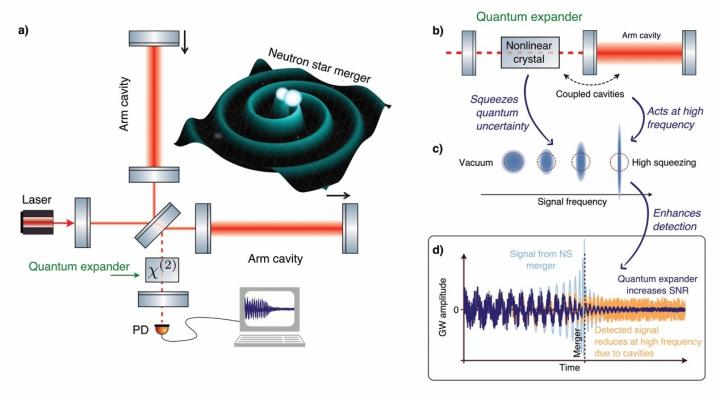
Credit: by Mikhail Korobko
Ultra-stable laser light that was stored in optical resonators of up to 4km length enabled the first observations of gravitational waves from inspirals of binary black holes and neutron stars. Due to the rather low bandwidth of the optical resonator system, however, the scientifically highly interesting post-merger signals at frequencies above a few hundred hertz could not be resolved. Such information would give access to the physics of neutron stars, allowing to study the ultra-dense quantum matter and possibly to find the missing link between gravity and quantum physics.
Recently, scientists MSc. Mikhail Korobko and Prof. Roman Schnabel from the University of Hamburg and Dr. Yiqiu Ma and Prof. Yanbei Chen from the California Institute of Technology proposed a novel all-optical approach to expanding the detection bandwidth of gravitational-wave observatories towards kilohertz frequencies.
What they call ‘quantum expander’ takes advantage of squeezing the quantum uncertainty of the laser light inside the optical resonator system. While squeezing the quantum uncertainty of the laser light before injection into the resonator system is already routinely used in all gravitational-wave observatories since April 2019, the new add-on will specifically improve the signal-to-noise-ratio at kilohertz frequencies, in fact, without deteriorating today’s high performance at lower frequencies.
The scientists propose placing a nonlinear crystal inside the so-called signal-recycling cavity, which is a subsystem in every gravitational-wave observatory today and pump this crystal with green laser light having half the wavelength of the main laser light used in the observatory. The interaction between the pump and the main light leads to a squeezed uncertainty in the quantum fluctuations of the main laser. When the signal-recycling cavity length is controlled to remain a non-integer multiple of the laser wavelength, especially the high frequency quantum fluctuations of the laser light are squeezed in addition to any squeezing injected from the outside.
The newly invented ‘quantum expander’ is fully compatible with previously invented quantum-noise-suppression techniques. It is intrinsically stable and doesn’t require significant modifications to the general topology of the observatories. What it does require is a further improved quality of optical components for further reduction in loss of photons. The ‘quantum expander’ may find applications beyond gravitational-wave detection in the areas of quantum metrology and quantum optomechanics.
###
Their research results were recently published in Light: Science and Applications.
Media Contact
Mikhail Korobko
[email protected]
Related Journal Article
http://dx.




